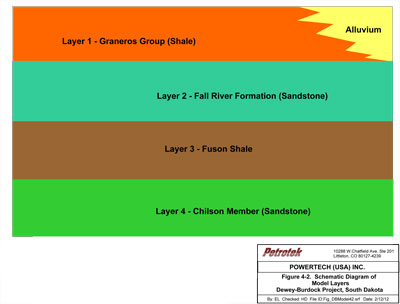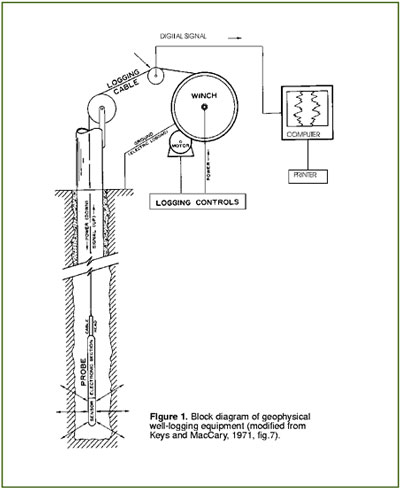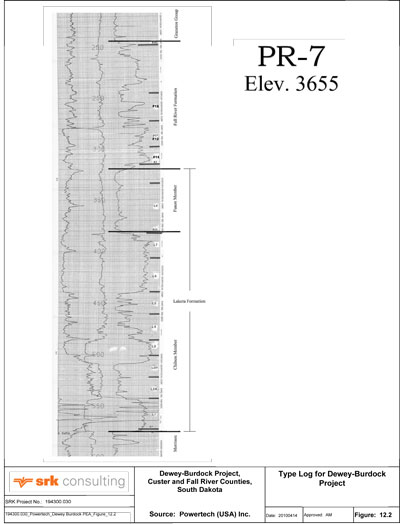DISCLOSURE CONTROVERSY WIDENS
Oglala Sioux Tribe learns of additional information not disclosed by Powertech as required by federal licensing hearing rules
Posted August 21, 2014
BREAKING NEWS: According to an August 20 Associated Press story in the Sioux Falls Argus Leader, the NRC's licensing board for the Dewey-Burdock project ruled yesterday that Powertech must disclose recently-acquired geological information to the Oglala Sioux Tribe and other intervenors. The information will not be released to the public. Since the ASLB's ruling has not been publicly released, details of the order are unknown.
Already enmeshed in a controversy over nondisclosure of newly-acquired borehole logs and maps, Powertech appears to have failed to disclose additional documents, according to a motion filed August 16 by the Oglala Sioux Tribe. The new data are relevant to contentions in this week's evidentiary hearing in front of the NRC's Atomic Safety and Licensing Board, according to the Tribe and the "Consolidated Intervenors".
In addition to reiterating its request that the ASLB compel disclosure of borehole logs, maps, and digital data purchased by Powertech after its NRC license was issued, the Tribe says Powertech should be compelled to disclose an application for a threatened/endangered species "take permit" submitted to the U.S. Fish and Wildlife Service in January and a July letter from the U.S. Bureau of Land Management requesting additional information on Powertech's mining plan of operations. The latter two items were mentioned in Powertech's August 11 Management Discussion and Analysis filed last week with Canadian securities regulators.
The Tribe argues that the undisclosed information is relevant to as many as five of the contentions admitted in the ASLB's three-day evidentiary hearing, which began on Tuesday in Rapid City. The hearing process will ultimately determine whether a license issued in April by NRC staff for the Dewey-Burdock project will be affirmed or withdrawn. If the ASLB requires disclosure, any new information creates an opportunity for the Tribe and other intervening parties to file new contentions.
The last-minute disclosure controversy has the potential to alter the ASLB's hearing schedule, which was established several months ago. Although the actual hearing was held this week, an initial decision by the ASLB can be as late as 90 days after the "closing of the record", which has not yet occurred.
 |
| Simplified diagram of sedimentary layers in the proposed Dewey-Burdock project area. |
Powertech triggered the controversy when it announced last month that it had purchased historical drill logs and maps from Energy Fuels Resources. The purchase included several thousand "electric" borehole logs and maps created in the 1970s and 1980s by the Tennessee Valley Authority. The logs show physical measurements of the subsurface geology made by instruments lowered into boreholes on "wireline" cabling.
Powertech used other previously-acquired borehole logs, as well as core samples, to define the type and thickness of rock and sediment layers in the project area. This type of information, along with data from aquifer pump tests, is necessary to help determine whether in-situ leach mining can be done safely and economically.
Powertech has disclosed little information about the newly-acquired borehole logs, including how the location of the boreholes compares to borehole logs already owned by the company. Consequently, it is impossible to determine if the newly-acquired data provide new geological information or if the data simply duplicate existing information, as argued by Powertech.
Complicating matters is the fact that Powertech apparently failed to disclose the previously-acquired borehole logs that were used to prepare its NRC license application. Powertech asserts that it does not have to disclose all of its borehole logs, implying that it can simply disclose a small sample and that it can pick and choose which logs to disclose.
The ASLB initially issued an unambiguous order directing Powertech to disclose the newly-acquired data within three days, but the company failed to comply. Instead, a Powertech attorney flouted the NRC's procedural rules and emailed the ASLB judges directly. The email began with the disingenuous statement that "Powertech wishes to request clarification on what is required of the company within the three day period".
Rather than a request for clarification, the email was simply a back door attempt to get the ASLB judges to reverse their earlier ruling. As pointed out by the Oglala Sioux Tribe in an August 12 formal response, the informal email violated federal regulations and should have been rejected by the ASLB, which ignored its own procedural rules and instead backtracked on its disclosure order. The ASLB 's reversal prejudiced the Tribe and denied its due process since it had no opportunity to respond to Powertech's email, according to the Tribe.
Powertech's email proposed that the ASLB "would benefit" from legal arguments from all parties regarding the disclosure issue and whether the data is relevant. The ASLB agreed, even though the Tribe and other intervenors did not have the benefit of knowing what the data contain, unlike Powertech.
 |
In its brief, Powertech argued that the relevance of the data depends on how the company intends to use it, not on what the data contains. And in an unusual move, Powertech CEO Dick Clement filed a supporting affidavit in which he asserted that the data were purchased solely to help delineate the location and quantity of uranium ore in the project area. He went on to explain that this is necessary so that the company can update its uranium resource estimate for the preparation of updated economic reports needed to secure additional financing for the project.
The borehole logs do not contain any plugging and abandonment information, and do not provide new information on the location of historical boreholes, according to Clement. Therefore, he asserts, the data are not relevant to the Tribe's Contention 3 which claims that the Supplemental Environmental Impact Statement (SEIS) contains inadequate hydrogeologic information to demonstrate the ability to contain migration of mining fluids and to assess potential impacts to groundwater.
Clement said he "can see no reason" why the new borehole logs are relevant, even though he states elsewhere in the affidavit that "drill hole data from thousands of electric logs already in Powertech’s possession...were used to prepare the project geologic model" and formed "the basis for the understanding of site stratigraphy". (Stratigraphy is the study of sedimentary and volcanic rocks layers.)
Understanding the site stratigraphy is critical, since successful in-situ leach uranium mining depends on the existence of relatively impermeable and continuous rock confining layers above and below the sandstone layers that are mined. The confining layers help to control the mining fluids and prevent excursions into overlying or underlying aquifers.
In the case of Dewey-Burdock, the two mineralized aquifer formations, the Fall River and Lakota/Chilson, are separated by the Fuson Shale. To effectively and safely mine either formation, the Fuson Shale must be impervious to the migration of mining fluids from one formation to another. Otherwise, excursions may result which can contaminate aquifers outside of the project area.
The Fuson Shale has been shown to leak, based on aquifer pump tests conducted by the Tennessee Valley Authority and more recently by Powertech. Powertech claims the leakage is due entirely to inadequately plugged historical exploration drill holes, and that these holes can be located and plugged. If some holes cannot be located, Powertech says it can design its wellfields in such a way that the unplugged holes are not a problem. This is the basis upon which the U.S. Nuclear Regulatory Commission issued a license to Powertech in April.
This claim is being challenged in the ASLB hearing. The Oglala Sioux Tribe's Contention 3 challenges Powertech's claim that it can contain the migration of mining fluids, and argues that the SEIS contains inadequate scientific data supporting Powertech's claim. In fact, the SEIS acknowledges there is a hydraulic connection between the Fall River and Chilson/Lakota aquifers through the intervening Fuson Shale, based on multiple aquifer pump tests.
But the SEIS notes that a Powertech consultant developed a "numerical groundwater model", and that Powertech concluded from the computer simulation that leakage through the Fuson Shale is caused by improperly installed or abandoned boreholes. NRC staffers responsible for the SEIS didn't question Powertech's conclusion, even though the report on the computer model prepared by Petrotek Engineering Corporation does not appear to support Powertech's claim. The report notes that additional aquifer pump testing must be conducted to determine if the leakage is due to communication through boreholes, or due to naturally-occurring pathways through the Fuson Shale.
 |
| Borehole log from Powertech's 2012 NI 43-101 Technical Report/Preliminary Economic Assessment for the Dewey-Burdock project. The dark horizontal lines mark the top and bottom of the Fall River Formation, the Fuson Shale, and the Chilson Member of the Lakota Formation (from higher to lower). Click here for larger version. |
The SEIS does not mention that the leakage may be due in part to faults or fractures in the shale, thinning or "discontinuities", or simply parts of the shale layer that are more permeable. A 1980 report by the TVA concluded that such "general leakage" as well as old unplugged boreholes were the cause of hydraulic communication between the Fall River and Chilson/Lakota aquifers. This conclusion does not appear in the SEIS.
Powertech appears to have diverted attention away from the "general leakage" theory since geological problems with the Fuson layer could call into question the Canadian company's ability to safely conduct in-situ leaching in the two target aquifers. Improperly plugged boreholes can theoretically be located and plugged, but inherent geological characteristics are another matter.
The fact that Powertech cited the Petrotek report when the report does not appear to support Powertech's position is disturbing. But perhaps more disturbing is the fact that NRC staff took Powertech's representations at face value, apparently without carefully reviewing the underlying source documents.
For the last several years, NRC staff seems to have consistently acted to expedite and accelerate the issuance of Powertech's license, rather than act impartially to ensure that the project will be protective of the environment and potentially-affected residents.
Most recently, NRC staff responded to the ASLB's August 8 disclosure order with a filing that can only be described as mystifying. While admitting that "the Staff knows nothing about the data beyond what Powertech states in the press release", the response confidently asserts that "regardless of what the data are, they do not appear to be relevant" to Contention 3. This statement is followed by a brief but inscrutable legal argument that likely reflects NRC staff's confusion about the matter.
Powertech's fight against disclosure of new borehole logs should be viewed in the context of the Canadian penny stock company's long history of nondisclosure of information on both the Dewey-Burdock project as well as the defunct Centennial project in northern Colorado. It took Powertech nearly four years to disclose to investors the existence of the ASLB's evidentiary hearing process on Dewey-Burdock, a legal proceeding that could potentially derail the project.
The extensive nondisclosure of information related to the Centennial project has been well documented on this website for years. Most noteworthy was Powertech's failure to fully explain to investors the lengthy and contentious, but ultimately unsuccessful, political and legal battle waged by the company against Colorado House Bill 08-1161 and associated regulations pertaining to in-situ leach uranium mining.
At this point it is unclear how the disclosure controversy will affect the ASLB hearing process. What is certain is that the disagreement will persist well past this week's hearing in Rapid City.
JW
ATOMIC SAFETY AND LICENSING BOARD HEARING FILE (Includes Oglala Sioux Tribe's August 16 Motion to Enforce Mandatory Disclosure Duties.)
"Analysis of aquifer tests conducted at the proposed Burdock uranium mine site, Burdock, South Dakota" prepared by J.M. Boggs and A.M. Jenkins, Tennessee Valley Authority - May 1980 (PDF 3,068 KB, 82 pages) See page 31 (page 40 of the PDF) for the conclusion on leakage through the Fuson Shale.